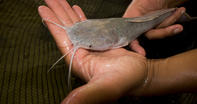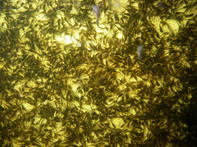
Farming Systems of Catfish
Due to their ability to utilise air directly as their oxygen source, along with their tolerance of poor water quality that would stress sensitive fish species, catfish can be farmed at high densities. This species is tropical in nature and grow optimally at a water temperature of 28°C. Under tropical conditions they are farmed in concrete tanks and the water is replaced with ‘new’ water daily to maintain water quality.In temperate climates, such as in Europe and South Africa, catfish are held indoors inside a greenhouse tunnel or warehouse, and the temperature maintained by means of electric heat pumps or boilers. Water is recirculated continuously between their tanks and powerful biological filters to remove and convert the fish's metabolic wastes into benign forms. These well-designed recirculating aquaculture systems (RAS) are capable of producing 1 ton of fish per 30 m² per month!
The use of green water ponds is not suitable for catfish farming in South Africa as the climate is too cold for optimal growth throughout the year. Any area where a temperature controlled environment can be created can be suitable for catfish production.
Temperature control, good water quality, excellent feed and good management are all essential elements of catfish farming. It is also vital to realise that a consistent power supply is needed as catfish cannot be farmed successfully unless power is present.
Growing Stages of Catfish

Life in captivity starts in the hatchery where the catfish adults are manipulated to produce their eggs and sperm. These are then mixed by the hatchery manager and placed in tanks to hatch.
Catfish eggs are sensitive to light, the tanks are covered with shade cloth or dark plastic sheets to keep the eggs and fry, baby fish, in dim lighting.
Catfish do everything fast and hatching is no exception; the eggs will hatch 24 hours after spawning. The fry utilises their yolk sacs for about 48 hours before starting to feed externally for the first time. At this point, the fry will be fed a mixture of natural and artificial feeds, leading to very rapid growth.
Because catfish are cannibals they need to be sorted weekly to ensure that each tank only contains similar-sized fish, otherwise the bigger fish will eat their smaller siblings.
Captive growth is rapid with catfish attaining 1 kg in six months after hatching and 2 kg at an age of eight months. To fuel this fast growth they are fed a high-quality diet. This feed looks like dog pellets and contains soya, maize, wheat, animal meal (blood, bone, poultry, etc) and a vitamin-mineral premix. Unfortunately, there are only two factories in South Africa that manufacture catfish feed and the feed costs can be expensive, making up around 2/3s of the total rearing costs.
Marketing of Catfish

Within Southern Africa, the fine, soft flesh of the catfish has not yet achieved the popularity it deserves. In Central and West Africa, this species is extremely popular with over 250 000 tons being farmed annually in Cameroon, Nigeria and the Democratic Republic of the Congo.
What is proving popular in South Africa, however, is value-added catfish products such as sausages, pâté and patties as well as smoked catfish fillets. It is expected that, as consumers realise the health and culinary benefits of eating catfish, the demand for this species will grow locally.
By Leslie Ter Morshuizen